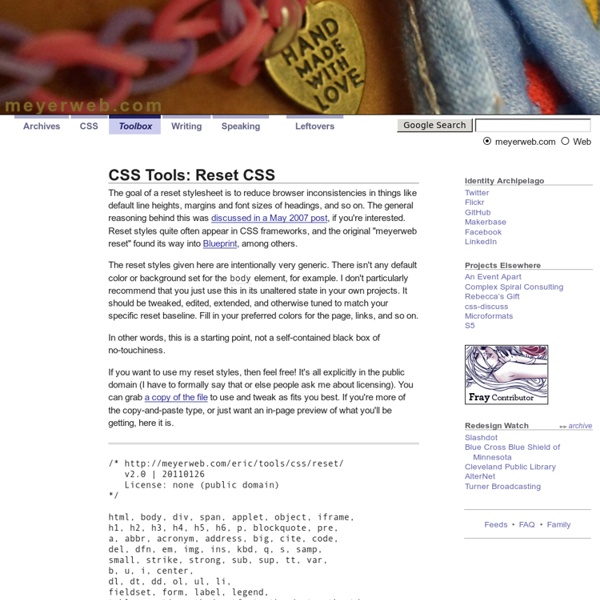A Beginner's Guide: Stepping Into Web Design Industry
Perhaps you've got some experience in the web industry but unsure what to do next. Or perhaps you are new to web design and you’re just starting out. Whatever the case, you are not alone. There are many others like yourself who are still feeling their way around in the dark. The web design industry is a big machine.
CSScomb: Sorting CSS Properties, The Better Way
This is our seventh article in a series that introduces the latest useful and freely available tools and techniques, developed and released by active members of the Web design community. The first article covered PrefixFree1; the second introduced Foundation2, a responsive framework; the third presented Sisyphus.js3, a library for Gmail-like client-side drafts. The fourth shared a free plugin called GuideGuide4 with us, and later we’ve announced Erskine’s responsive grid generator Gridpak5 and JS Bin6. This time we present CSScomb, a tool to help you sort and categorize CSS properties in your code to improve maintenance. As of this writing, Web browsers support about 200 different CSS properties.
50+ Useful CSS3 Tutorials to Enhance Your Skills
People in the web design community now has been talking about the wonders brought about by CSS3. Obviously, it is does not only control the styling of the web page as what CSS2 does, but also the behavioral attributes of the design. This novel technology certainly makes it convenient for you to add animations and transitions right on your stylesheet.
8 jQuery And CSS Parallax Scrolling Tutorials
Parallax scrolling is a type of web design where different elements of a website move at different speeds. As a user navigates through parallax websites, images will float on top of other images in several layers. Parallax scrolling sites can be used in many different ways to create a variety of captivating effects which have the potential to keep viewers on your site for a great deal of time. So if you are bored using the plugin and challenged to create you own parallax scrolling effects using jQuery and CSS, you might want to try these tutorials below. With this tutorial, you’ll learn how to integrate a simple scrolling parallax. Since then, parallax has blown up.
Planning And Implementing Website Navigation - Smashing Magazine
Advertisement The thing that makes navigation difficult to work with in Web design is that it can be so versatile. Navigation can be simple or complex: a few main pages or a multi-level architecture; one set of content for logged-in users and another for logged-out users; and so on. Because navigation can vary so much between websites, there are no set guidelines or how-to’s for organizing navigation. Designing navigation is an art in itself, and designers become better at it with experience. It’s all about using good information architecture: “the art of expressing a model or concept of information used in activities that require explicit details of complex systems.”
Semantics - Dive Into HTML5
You are here: Home ‣ Dive Into HTML5 ‣ Diving In his chapter will take an HTML page that has absolutely nothing wrong with it, and improve it.
CSS Tools: Reset CSS
The goal of a reset stylesheet is to reduce browser inconsistencies in things like default line heights, margins and font sizes of headings, and so on. The general reasoning behind this was discussed in a May 2007 post, if you're interested. Reset styles quite often appear in CSS frameworks, and the original "meyerweb reset" found its way into Blueprint, among others. The reset styles given here are intentionally very generic. There isn't any default color or background set for the body element, for example. I don't particularly recommend that you just use this in its unaltered state in your own projects.
CSS Refreshers: Borders
Sure, we’re all familiar with borders. Is there anything new that could possibly be introduced? Well, I bet there’s quite a few things in this article that you never knew about! Not only can CSS3 be used to create rounded corners, but plain-ole' CSS can also be wrestled into displaying custom shapes. That’s right; in the past, before these techniques were discovered, we might have resorted to using absolutely positioned background images to display circles or arrows. Thankfully - as we gleefully take one more step away from Photoshop - this is no longer the case.
Why tables for layout is stupid: problems defined, solutions offered: Everything on one page)
There are certain things that CSS does not do as well as table layouts. For instance, say you have a black side nav bar that you want to extend the whole height of your content. With a table layout, this is a piece of cake: just give that <td> a black background. We can do this with CSS, but it requires a different way of thinking.
Experiments with wide images
1. A very wide image contained in a paragraph with no styles applied Dunstan kindly lent me this charming image. Pellentesque in felis quis tortor consectetuer condimentum. Phasellus nibh nibh, interdum sit amet, sagittis nec, cursus sit amet, dolor.
Using CSS3 @font-face to “fake” multiple font weights - Ilia Draznin
CSS2 specifies additional font weights, beyond Normal and Bold. In particularly there are 9 font weights in total — 100, 200, 300, 400 (normal), 500, 600 (bold), 700, 800 and 900. Unfortunately browsers still somewhat lack support for this feature, but more importantly fonts lack support for this. Many fonts however, still come with only normal and bold weights.



